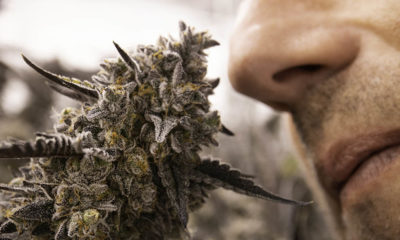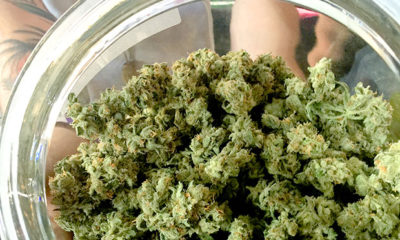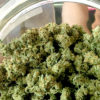
Medical
Cannabis & Dopamine: Link Reveals Both Risks & Potential
Researchers are exploring the connection between cannabinoids and dopamine in the human brain, which controls such phenomena as motivation, addiction and euphoria. Investigations are revealing both the potential for treatments of psychiatric disorders and possible risks from heavy use.
The cannabis plant contains over 100 different cannabinoids, each interacting with the human brain in a specific way. Researchers are increasingly focusing on the key role dopamine plays in those interactions.
This is not surprising, as dopamine is critical to the brain’s “reward system,” which has a part in creating motivation by “rewarding” us with a euphoric kick — or, in its negative role, denying us that kick. This, in turn, makes dopamine crucial to understanding addiction and other behavior patterns identified as pathological, such as depression.
The ongoing research into cannabis and dopamine may shed light on the recent string of much-hyped claims linking cannabis use to “psychosis and schizophrenia” — and what the actual risks, and potential benefits, really are.
All About the Dopamine
The evidence for a cannabinoid-dopamine link has been mounting for some time. What exactly the link is, and what it means for long-term users, is not yet clear.
A 2016 British study on the website of the National Center for Biotechnology Information found that “the available evidence indicates that THC exposure produces complex, diverse and potentially long-term effects on the dopamine system, including increased nerve firing and dopamine release in response to acute THC and dopaminergic blunting associated with long-term use.”
This suggests an immediate buzz from “increased nerve firing,” but diminishing returns as dopamine production is “blunted” (no pun intended, we may presume). This is a pattern that may seem familiar to many long-term users.
A paper entitled “A Brain on Cannabinoids: The Role of Dopamine Release in Reward Seeking,” published in 2012 by Cold Spring Harbor Perspectives in Medicine, reviewed several recent studies to postulate that problems with dopamine release could be the cause for “cannabis-withdrawal syndrome.”
It stated that quitting pot can cause “anxiety/nervousness, decreased appetite/weight loss, restlessness, sleep difficulties including strange dreams, chills, depressed mood, stomach pain/physical discomfort, shakiness, and sweating.” This all may seem rather overstated, but it is plausible that cannabis creates its craving by monkeying with the dopamine-regulated reward system. “It is likely,” the paper concluded, “that these withdrawal symptoms contribute to cannabis dependence through negative reinforcement processes.”
According to the National Institute on Drug Abuse (NIDA), THC’s effects on mood are determined by two types of neurons: GABA neurons and glutamatergic (glutamate-releasing) neurons.
GABA cells (for gamma-aminobutyric acid, the type of neurotransmitter these cells pick up) block the release of dopamine in order to keep you more stable, but THC can inhibit the release of GABA neurons. When the GABA neurons are inhibited, you get that pleasant dopamine rush. When the glutamatergic cells are inhibited, your brain is deprived of glutamate — which, akin to dopamine, is associated with pleasure, and closely interacts with it.
This dual effect may explain why some people enjoy cannabis and others do not: “Whether the drug is experienced as rewarding or aversive depends in large part on which of the two neuron types is inhibited more,” the NIDA wrote. And this can vary from organism to organism. “As a result, when a person is exposed to THC, the experience can be rewarding, aversive, or neutral.”
Cannabinoids As ‘Anti-Psychotic’ Treatment
Recent research has looked to cannabinoids as possible treatments for psychiatric disorders — and like most such treatments, this has to do with the impact on how dopamine is produced and transmitted in the brain.
Traditional “antipsychotics” appear to function by controlling the release of neurotransmitters such as dopamine, noradrenaline, acetylcholine and serotonin. An August article in Medical Life Sciences News states, after reviewing six peer-reviewed studies: “The dopamine hypothesis, which has dominated psychosis treatment to date, postulates that an excess of dopamine in the brain causes psychotic symptoms.”
Antipsychotic medications widely in use today bind to dopamine receptors, thus reducing dopamine production. But for those people who do not respond to these traditional pharmaceuticals, cannabinoids are being explored as an alternative treatment.
CBD is particularly looked to as a possible “new class of treatment for psychosis.” Citing recent studies, the Medical Life Sciences report finds: “When the effects of CBD as an adjunct to conventional antipsychotic medication are examined, modest improvements are found on cognition and the impact of patients’ illness on their quality of life and global functioning.”
But if CBD is chilling your dopamine out, THC might be flooding your neuro-receptors with the stuff — at least initially. That’s because while CBD appears to be an antagonist of the endocannabinoid system’s CB1 receptors, TCH appears to activate those same CB1 receptors, causing feelings of euphoria.
Long-Term Brain Changes?
The same cannabinoid-dopamine link that holds hope for new treatments may also point to risks for heavy cannabis users, especially those whose brains are still developing. A 2017 study by researchers at Utah’s Brigham Young University, published in the journal JNeurosci, found evidence that long-term cannabis use may in fact change the brain.
The study focused on the ventral tegmental area (VTA), a region of the brainstem identified as one of the two most important clusters of dopamine receptors (the other is the adjacent substantia nigra). The researchers examined how the VTA’s cells changed in adolescent mice that received a week of daily THC injections. They compared the results on normal mice and “CB1 knockout mice” — that is, those genetically tweaked to disable their CB1 receptors. They especially looked for impacts on GABA cells.
The findings determined that “THC acutely depresses GABA cell excitability” — which actually means that high-THC cannabis can overcome the GABA cells and cause the release of more dopamine, giving you that sought-after buzz.
Here the team postulates a clue to the brain mechanism behind what is called “cannabis use disorder” — defined by the Diagnostic and Statistical Manual of Mental Disorders-5 as a “problematic pattern of cannabis use leading to clinically significant impairment or distress.”
Of course, critics have pointed out that such categories are inherently question-begging: Is the “impairment or distress” actually caused by the cannabis use, or are people who suffer from such “impairment or distress” for unrelated reasons self-medicating (consciously or not) with cannabis? If the latter, cannabis use may actually be having a positive, therapeutic effect on sufferers, and the theorists of “cannabis use disorder” may be reading things precisely backwards.
Some Skepticism Warranted
How this research is applied and interpreted by the psychiatric establishment definitely demands some critical scrutiny, given the long-entrenched prejudice against cannabis, and bias in favor of prescription pharmaceuticals.
In 2014, numerous media reports (both American and British) touted a study published in the Proceedings of the National Academy of Sciences purporting to link cannabis use to anxiety and depression. The researchers studied the brains of 24 cannabis “abusers” — defined as those who smoke multiple times a day — and how they reacted to methylphenidate (more commonly known as Ritalin), a stimulant used to treat hyperactivity and attention-deficit disorder. The study found the “abusers” had “blunted” behavioral, cardiovascular and brain responses to methylphenidate compared with control participants. The “abusers” also scored higher on negative emotional reactions. The researchers concluded that cannabis interferes with the brain’s reaction to dopamine.
Mitch Earleywine, professor of psychology at SUNY Albany, speaking to this reporter at the time, raised the same questions about possible confusion of cause and effect in such studies.
“I think that giving folks Ritalin or any other stimulant in an effort to assess dopamine release says little if anything about how cannabis users would respond to natural sources of reinforcement,” Earleywine said. “These people also weren’t randomly assigned to use cannabis, so we have no idea if the altered dopamine reaction preceded or followed cannabis use. Finally, I think if any Big Pharma product did the exact same thing in the lab, we’d be reading about how it protected people against the addictive potential (and induced dopamine release) associated with Ritalin or other stimulants.”
TELL US, do you think cannabis is addictive?


















